Module 1 - I101
I101: Using ITS Standards: An Overview
HTML of the PowerPoint Presentation
(Note: This document has been converted from a PowerPoint presentation to 508-compliant HTML. The formatting has been adjusted for 508 compliance, but all the original text content is included, plus additional text descriptions for the images, photos and/or diagrams have been provided below.)
Slide 1:

(Extended Text Description: Slide 1: Welcome - Graphic image of introductory slide. A large dark blue rectangle with a wide, light grid pattern at the top half and bands of dark and lighter blue bands below. There is a white square ITS logo box with words “Standards ITS Training” in green and blue on the middle left side. The word “Welcome” in white is to the right of the logo. Under the logo box are the words “RITA Intelligent Transportation Systems Joint Program Office.”)
Slide 2:
Welcome

Shelley Row, P.E., PTOE
Director
ITS Joint Program Office

(Extended Text Description: Slide 2: Screen capture snapshot of RITA website - for illustration only. Below this image is a link to the current website: https://www.its.dot.gov/pcb - this screen capture snapshot shows an example from the RITA website from June 3, 2011. At the top of the page it shows the RITA logo with the text Research and Innovative Technology Administration - Intelligent Transportation Systems. Below the main site banner, it shows the main navigation menu with the following items: About RITA, Communities of Interest, Contact Us, Press Room, RITA Offices, Site Map, and a Search button. Below the main navigation menu, it shows a sub-navigation menu with the following items: About Us, T3 Webinars, ITS Peer-to-Peer, Resources, Local ITS PCB and Testimonials. Beneath the sub-navigation menu, the page is sub-titled "ITS Professional Capacity Building Program" and is divided into sub-sections such as "Welcome to ITS Professional Building", "News", "ITS Technical Assistance" and "Scheduled T3 Webinars". Again, this image serves for illustration only. The current website link is: https://www.its.dot.gov/pcb)
(Note: There is additional text attached to this slide that includes the following introductory information from Shelley Row):
"ITS Standards can make your life easier. Your procurements will go more smoothly and you’ll encourage competition, but only if you know how to write them into your specifications and test them. This module is one in a series that covers practical applications for acquiring and testing standards-based ITS systems.
I am Shelley Row the director of the ITS Joint Program Office for USDOT and I want to welcome you to our newly redesigned ITS standards training program of which this module is a part. We are pleased to be working with our partner, the Institute of Transportation Engineers, to deliver this new approach to training that combines web based modules with instructor interaction to bring the latest in ITS learning to busy professionals like you.
This combined approach allows interested professionals to schedule training at your convenience, without the need to travel. After you complete this training, we hope that you will tell colleagues and customers about the latest ITS standards and encourage them to take advantage of the archived version of the webinars.
ITS Standards training is one of the first offerings of our updated Professional Capacity Training Program. Through the PCB program we prepare professionals to adopt proven and emerging ITS technologies that will make surface transportation safer, smarter and greener which improves livability for us all. You can find information on additional modules and training programs on our web site ITS PCB Home.
Please help us make even more improvements to our training modules through the evaluation process. We look forward to hearing your comments. Thank you for participating and we hope you find this module helpful."
Slide 3:

Slide 4:
Course Information
- Prerequisites: None
-
Target Audience:
- Public sector managers
- Decision makers
Slide 5:
Instructor

Gary B. Thomas, P.E., Ph.D.
Center Director
Texas Transportation Institute
College Station, TX, USA
Slide 6:
Curriculum Path (SEP)
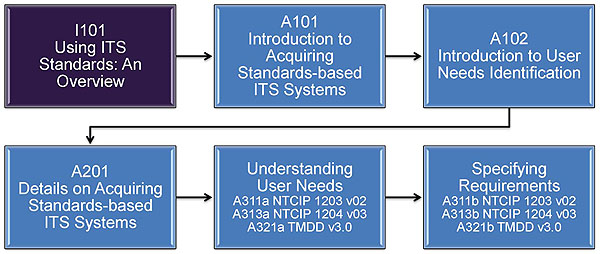
(Extended Text Description: Curriculum Path (SEP). A flow chart with six graphic boxes in two rows of three showing the curriculum path for implementing a system that uses standards that are based on the systems engineering process. The first box on the top left is a darker blue and starts with “I101 – Using Standards: An Overview” with a small arrow leading to the second middle top box marked “A101 – Introduction to Acquiring Standards-based ITS Systems” with an arrow leading to the last box on the top row, containing “A102 – Introduction to User Needs Identification.” A long bending arrow leads down and back across to the left side between the two rows of graphic boxes to the first box on the lower left side, which says “A201 – Details on Acquiring Standards-Based ITS Systems” with an arrow leading to the lower middle box, “Understanding User Needs” with three statements below reading “A311a NTCIP 1203 v02,” “A313a NTCIP 1204 v03,” and “A321a TMDD v3.0” with an arrow leading to last box on the lower row, stating “Specifying Requirements” with statement below reading “A311b NTCIP 1203 v02,” “A313b NTCIP 1204 v03,” and “A321b TMDD v3.0.”)
Slide 7:
Curriculum Path (Non-SEP)

(Extended Text Description: A flow chart of nine box in three rows of three, showing the curriculum path for implementing a system that uses standards that are not based on the systems engineering process. The first darker blue box contains the words “I101 – Using Standards: An Overview” with an arrow leading to the second box in the top row, stating “A101 – Introduction to Acquiring Standards-based ITS Systems” with an arrow leading to the last box “A102 – Introduction to User Needs Identification.” The arrow from this last box curves down and back to the left between the rows leading to the first box on the middle row, which states “A201 – Details on Acquiring Standards-Based ITS Systems” with an arrow leading to the second middle box, stating “A202 – Identifying and Writing User Needs when ITS Standards Do Not Have SEP Content” with an arrow leading to the third box of the middle row, stating “A103 – Introduction to ITS Standards Requirements Development.” The arrow from this last box curves down and back to the left between the rows to point to the left box on the third (bottom) row, which states “A203 – Writing Requirements When ITS Standards Do Not Have SEP Content” an arrow leading to the second box of the last row, stating “A3xxa – Identifying and Writing Specific User Needs for NTCIP 12xx vxx” with an arrow leading to the last box on the third row, stating “A3xxb – Specifying Requirements for NTCIP 12xx vxx.” The last two boxes are denoted with an asterisk that indicates these two modules are expected in year 2 of the training program.)
*Expected in year 2 of training modules
Slide 8:
Learning Objectives
- Identify the benefits and costs of using standards in ITS projects
- Describe the benefits of using the systems engineering process in ITS projects
- Identify and address high-level technical and institutional challenges to using standards
- Describe the role of ITS standards in ITS applications
Slide 9:
What Are Standards?
-
Established norm or requirement about technical systems that establishes:
- Uniform engineering or
- Technical criteria, methods, processes, and practices
-
Most standards are:
- Voluntary
- Consensus based
- Open
Slide 10:

Slide 11:
Learning Objective #1
Benefits of Using Standards
- What do you see as possible benefits of using standards?
- Use the chat pod to answer
Slide 12:
Learning Objective #1
What Are ITS Standards?
-
Define how ITS systems, products, and components:
- Interconnect...
- Exchange information...
- Interact.
- Within a transportation network
- They are not design standards
Slide 13:
Learning Objective #1
Benefits
- Supports interoperability
- Supports 940 compliance
- Minimizes future integration costs
- Facilitates regional integration
- Supports incremental measurable development
- Prevents technological obstacles
- Minimizes operations and maintenance costs
- Prepares for emerging technologies
- Makes procurements easier
- Makes testing easier
Slide 14:
Learning Objective #1
Benefits
Supports interoperability
-
The ability of an ITS system to:
- Provide information and services to other systems
- Use exchanged information and services to operate together effectively
- Analogy: home theater system
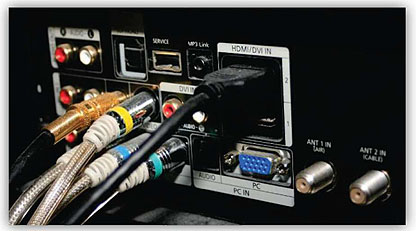
Source: Gary B. Thomas
Slide 15:
Learning Objective #1
Benefits
Supports interoperability

(Extended Text Description: A simple graphic with large oval in the center and six graphic boxes around it, three above and three below. The first box at the top left states “Amplifier,” the middle top box states “Receiver,” and the last top box states “MP3 player.” On the bottom, the first box states “Record turntable,” the middle box states “CD player,” and the last box (in brighter blue) states “Future device?” The center oval states “Audio standards” and each of the boxes is connected to the center oval via small straight lines.)
Slide 16:
Learning Objective #1
Benefits
Supports Rule 940 Compliance
- FHWA rule enacted on January 8, 2001
- Requires a systems engineering analysis for ITS projects using highway trust funds
-
Seven requirements included in the SE analysis (see supplemental materials)
- #6 states: Identification of applicable ITS standards and testing procedures
Slide 17:
Learning Objective #1
Benefits
Minimizes Future Integration Costs
- Not locked into proprietary systems
- Expansion is easier
- Still allows for innovation
Slide 18:
Learning Objective #1
Benefits
Facilitates Regional Integration
- Makes it easier to communicate with other jurisdictions
- Reduces miscommunication
- Improves coordination of field devices
Slide 19:
Learning Objective #1
Benefits
Others
- Supports incremental measurable development
- Prevents technological obstacles
- Minimizes operations and maintenance costs
- Prepares for emerging technologies
- Makes procurements easier
- Makes testing easier
- Minimizes risk
Slide 20:

Slide 21:
Learning Objective #1
Costs of Using ITS Standards
- What do you think are potential COSTS of implementing a standards-based system?
- Use the chat pod to answer
Slide 22:
Learning Objective #2
Systems Engineering Process (SEP)

(Extended Text Description: Systems Engineering Process (SEP). A graphic of the systems engineering process. The main graphic of the SEP is the V shape in yellow with some additional horizontal extensions on the left and right side of the top of the V. The two left and right extensions and the main V shape in yellow are sub-divided by blue lines. Starting from the left extensions the sections are first “Regional Architecture,” which is separated from the next sections by a white space/curved break, then second “Needs Assessment,” third “Concept Selection,” then a blue "Decision Gate" line and last before the left top of the diagonal part of the V shape “Systems Engineering Management Planning.” At this point the sections begin to descend the left diagonal side of the V shape with a blue "Decision Gate" line, “Concept of Operations,” blue "Decision Gate" line, “System Requirements,” blue "Decision Gate" line, “High-level Design," blue "Decision Gate" line, "Subsystem Requirements,” blue "Decision Gate" line and “Detailed Design.” The juncture at the bottom of the two diagonal portions of the V-shape is designated “Software Coding and Hardware Fabrication” and is separated from each section in the left and right diagonals by blue "Decision Gate" lines. At this point the sections begin to ascend the right side of the V with “Unit Testing,” a blue "Decision Gate" line, “Subsystem Integration,” a blue "Decision Gate" line, “Subsystem Verification,” “System Integration System Verification,” a blue "Decision Gate" line, “Initial Deployment,” “System Validation,” a blue "Decision Gate" line and “Operations and Maintenance.” At this point there is a white space between the top of the diagonal and the horizontal extension. The sections on the right extension from the top of the right diagonal side of the V proceed with “Changes and Upgrades,” a blue "Decision Gate" line and “Retirement/Replacement.” These SEP steps can also be described as parts of phases which are listed across the top of the graphic in a series seven gray gradated boxes: starting at the left “Phase -1 (Interfacing with Planning and the Regional Architecture),” “Phase 0 (Concept Exploration and Benefits Analysis),” “Phase 1 (Project Planning and Concept of Operations Development),” “Phase 2 (System Definition and Design),” “Phase 3 (System Development and Implementation),” “Phase 4 (Validation, Operations and Maintenance, Changes and Upgrades),” and finally at the far right “Phase 5 (System retirement/replacement).” Numerous cross-cutting activities are listed vertically in a gray gradated box with eleven narrow rectangular sections to the left of the V diagram (bottom left side of the entire graphic image). Starting from the top, the list includes: “Stakeholder involvement,” “Elicitation,” “Project Management Practices,” “Risk Management,” “Program Metrics,” “Configuration Management,” “Process Improvement,” “Decision Gates,” “Trade Studies,” “Technical Reviews,” and “Traceability.” There is a long thin arrow pointing down along the left diagonal labeled “Decomposition and Definition.” There is a long thin arrow pointing horizontally to the right at the bottom of the V shape labeled “Life Cycle Time Line.” There is a long thin arrow pointing up along the right diagonal labeled “Integration and Recomposition.” Directly under this line and slightly to the right of the V shape is a key for the blue lines labeled “Decision Gate.”)
Slide 23:
Learning Objective #2
Needs, Requirements, and Traceability
- Focus on the WHAT - not the HOW
- Every need has at least one requirement
- Every requirement should trace to at least one need
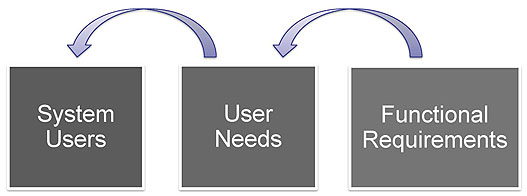
(Extended Text Description: A diagram with three dark gray boxes in a single row. The first box (on the left) is labeled “System Users”. The second box (in the middle) is labeled “User Needs” and is connected by a curved blue one-way arrow back to the first box. The third box (on the right) is labeled “Functional Requirements” and is connect by a curved blue one-way arrow back to the second box.)
Slide 24:
Learning Objective #2
Benefits of Using SEP
- Provides framework and process to verify that the system meets user needs
- Improved stakeholder participation
- More adaptable, resilient systems
- Verified functionality and fewer defects
- Higher level of reuse from one project to the next
- Better documentation
Slide 25:
Learning Objective #2
How Do Standards Relate to SEP?
- Primarily used in the design stage of SEP
- After the concept of operations and initial project planning has been developed
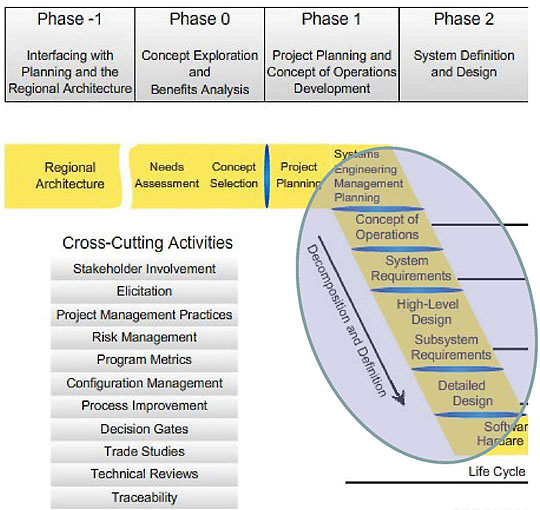
(Extended Text Description: The left half of the systems engineering process (SEP) V diagram graphic that highlights the descending side of the “V” diagram. Starting from the left extensions the sections are first “Regional Architecture,” which is separated from the next sections by a white space, then second “Needs Assessment,” third “Concept Selection,” and last before the left top of the diagonal part of the V shape “Systems Engineering Management Planning.” At this point the sections begin to descend the left diagonal side of the V shape with “Concept of Operations,” “System Requirements,” “High-level Design Subsystem Requirements,” and “Detailed Design.” The juncture at the bottom of the two diagonal portions of the V-shape is designated “Software Coding and Hardware Fabrication.” across the top of the graphic in a series four of the seven gray gradated boxes: starting at the left “Phase -1 (Interfacing with Planning and the Regional Architecture),” “Phase 0 (Concept Exploration and Benefits Analysis),” “Phase 1 (Project Planning and Concept of Operations Development),” “Phase 2 (System Definition and Design).” Numerous cross-cutting activities are listed vertically in a gray gradated box with eleven narrow rectangular sections to the left of the V diagram (bottom left side of the entire graphic image). Starting from the top, the list includes: “Stakeholder involvement,” “Elicitation,” “Project Management Practices,” “Risk Management,” “Program Metrics,” “Configuration Management,” “Process Improvement,” “Decision Gates,” “Trade Studies,” “Technical Reviews,” and “Traceability.” There is a large light gray over laid on top of the left diagonal section of the V shape, with a long thin arrow pointing downwards in parallel with the left diagonal section of the V shape, labeled “Decomposition and Definition.” At the bottom is a partial line with words “Life Cycle.”)
Slide 26:
Learning Objective #2
SEP-based Standards
- Early ITS standards were not developed using SEP
- Some have been redeveloped using SEP
- SEP-based standards include user needs, requirements, needs to requirements and requirements to design matrices and design solutions
- SEP-based standards better ensure that systems will be conformant to ITS standards
Slide 27:

Slide 28:
Learning Objective #3
Technical and Institutional Challenges
- What do you think some of the most common technical challenges are?
- Use chat pod to answer
- What do you think some of the most common institutional challenges are?
- Use chat pod to answer
Slide 29:
Learning Objective #3
Technical and Institutional Challenges
Technical
- Gaps in existing skills
- Inconsistent industry support for standards
- Conformance to standards
- Paradigm shift from non-standards based to standards based
- Paradigm shift from non-SE based to SE-based
Institutional
- Not everyone in an agency is willing to articulate their needs
- Resistance to change
- Not all agencies have bought into regional integration
- Paradigm shift from non-standards based to standards based
- Paradigm shift from non-SE based to SE-based
Slide 30:
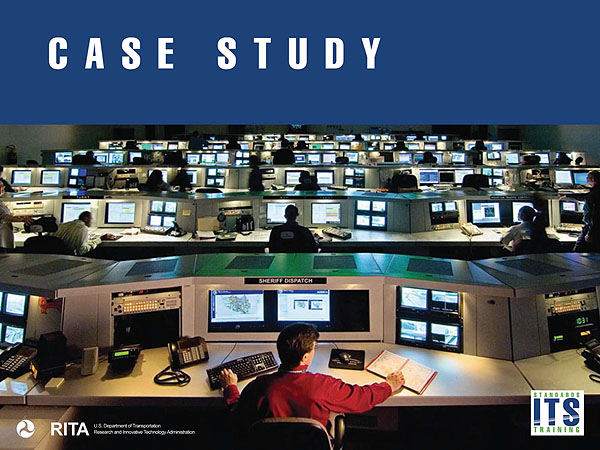
Slide 31:
Learning Objective #3
Lessons From the Field
Functional Integration
- Develop usable systems that meet user needs, assess user needs, and follow accepted usability engineering practices when developing interactive systems
- Use ITS standards when developing systems to maximize vendor flexibility and data exchange compatibility and ensure comprehension by agencies
Slide 32:
Learning Objective #3
Lessons From the Field
Jurisdictional Integration
- Create systems and plans that allow information sharing and coordination among regional agencies and states
- Consider developing an emergency response plan that coordinates command, control, and communications among regional agencies
Slide 33:
Learning Objective #3
Lessons From the Field
Legacy Systems
- Comply with standards and select proven commercial off-the-shelf technology (hardware and software) when possible to save money and facilitate integration with existing legacy systems
- To identify and resolve system integration issues with existing legacy equipment, plan on adequate development time and thorough system testing to ensure systems are working properly after system integration
Slide 34:
Learning Objective #3
Lessons From the Field
Functional integration
- TriMet (Oregon)
- Traffic Management Center (TMC) study
Jurisdictional integration
- Washington, DC metro area
- Iowa DOT
Legacy systems
- TriMet
Slide 35:
Learning Objective #3
Lessons From the Field
Functional Integration
TriMet's LED signs
- No TCP/IP standards existed for LED sign interface
- TriMet provided specs that required vendors to interface with protocols
- Such compliance ensured a modular and compatible infrastructure
- Benefits: Supports interoperability, facilitates regional integration, minimizes operations and maintenance costs
Slide 36:
Learning Objective #3
Lessons From the Field
Functional Integration
TMC Study
- 10 states
- Use of standards allows better coordination of TMC efforts
- Increased efficiency of traffic and emergency operations
- Incomplete/inaccessible information is an impediment
- Benefits: Facilitates regional integration
Slide 37:
Learning Objective #3
Lessons From the Field
Jurisdictional Integration
Washington. DC metro area
- September 11 revealed negative consequences of a lack of coordination
- No communication between different DOTs or between DOTs and transit agencies
- Emergency evacuation strategies hampered
- Benefits: Facilitates regional integration, supports interoperability
Slide 38:
Learning Objective #3
Lessons From the Field
Jurisdictional Integration
Iowa DOT
- Statewide ITS architecture emphasized interoperability between transit agencies
- Template developed for ITS contracts
- Transit agencies must agree to terms in contract template
- Benefits: Supports interoperability, makes procurements easier
Slide 39:
Learning Objective #3
Lessons From the Field
Legacy Systems
TriMet's TransitTracker
- Built upon an existing bus dispatch system and rail central control system
- Same platform for existing and proposed systems
- Saved software development time and costs
- Benefits: Minimizes future integration costs, makes procurements easier
Slide 40:

Slide 41:
Learning Objective #3
Lessons From the Field Participant Experiences
- What lessons have you learned from your own projects?
- Answer in chat pod
Slide 42:
Learning Objective #4
Role of ITS Standards in ITS Applications

(Extended Text Description: Role of ITS Standards in ITS Applications. A graphic showing the relationship between centers and field devices. The first box on the left side has a blue top portion with a subhead “Information Service Provider” and a lower light gray portion with “Private Sector Traveler Information Services” + “City Web Site” + “State 511 System.” This box is connected to the middle box by a dashed blue arrow pointing to the right “Request for road network conditions” and another dashed blue arrow pointing to the left “Road network conditions,” indicating planned and future data flows. Under these arrows are the words “Center to Center.” The second box has a blue top portion with a subhead “Traffic Management” and a lower light gray box with a traffic management center, “City Traffic Operations Center.” It is connected to the third box on the right by a series of four solid blue arrows indicating existing data flows. The top arrow points to the right and is labeled “Video Camera Control” and the second arrow points to the left and is labeled “Traffic images.” These two arrows are connected by a light blue oval labeled “NTCIP 1205.” The third arrow down points to the left and is labeled “Traffic flow.” The last arrow points to the right and is labeled Traffic sensor control.” These last two arrows are connected with an overlapping light blue oval labeled “NTCIP 1206.” Under these arrows are the words “Center to Field.” The third box on the right has a blue portion with a subhead “Roadway System” with a lower light gray portion including “City Field Equipment.” The top data flow represents video camera control from the TMC to the roadway subsystem and is defined by NTCIP 1205. The bottom two flows represent traffic flow data (from the field equipment) and traffic sensor control (to the field equipment). These are defined by NTCIP 1206. There is a small key indicating that the solid blue arrows are “Existing Flow” and the dashed blue arrows are “Planned and future flow.”)
Slide 43:
Review of Learning Objectives
- Identify the benefits and costs of using standards in ITS projects
- Describe the benefits of using the systems engineering process in ITS projects
- Identify and address high-level technical and institutional challenges to using standards
- Describe the role of ITS standards in ITS applications
Slide 44:
Student Supplement

(Extended Text Description: Student Supplement cover graphic. A large dark blue rectangle with a wide, light grid pattern at the top half and bands of dark and lighter blue bands below. There is a white square logo box with words “Standards ITS Training” in green and blue on the middle left side. The word “Welcome” in white is to the right of the logo. Under the logo box are the words “RITA Intelligent Transportation Systems Joint Program Office.”)
- ITS Standards FAQ
- General ITS standards reference information
- ITS Architecture and Standards Final Rule (01/08/01)
Slide 45:

Slide 46:
For More Information
RITA/ITS Web site
ITE Web site
ITS Architecture Implementation Program
NTCIP Web site
Systems Engineering Guide for ITS
Slide 47:
Next Course
A101: Introduction to Acquiring Standards-Based ITS Systems
The module provides key reference points and information for participants to be able to communicate procurement strategies for standards-compliant systems.